| Author |
Topic: 8 String Bender Lap Steel |
Peter den Hartogh
From:
Cape Town, South Africa
|
 Posted 24 Jun 2012 8:46 am
Posted 24 Jun 2012 8:46 am |
|
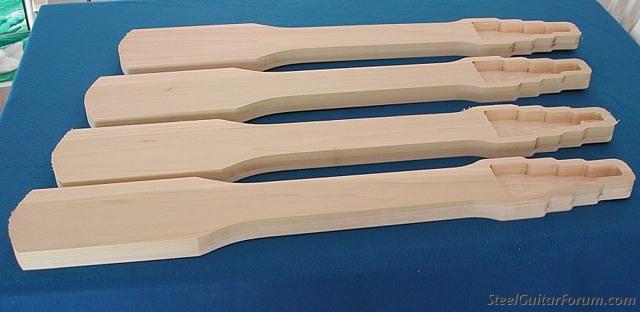
A short while ago I purchased one of George Piburn's
"GeorgeBoards Steel Guitars" blank bodies.
I had a Duesenberg Bender lying around, so I used the opportunity to build an 8 string steel guitar with this bender.
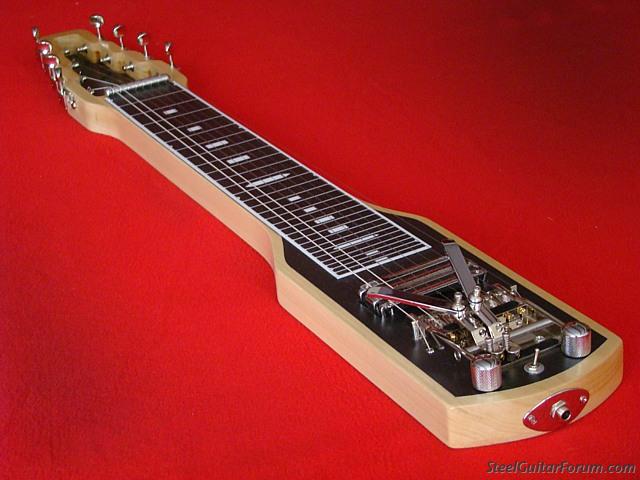
Unfortunately the bender accommodates only 6 strings so I had to make two "mini bridges" for string 1 and string 8. They were made from 4 mm chromed rods which I robbed from some bathroom equipment and I shaped the "heads" with a Dremel tool. The rods are deeply embedded into the body.
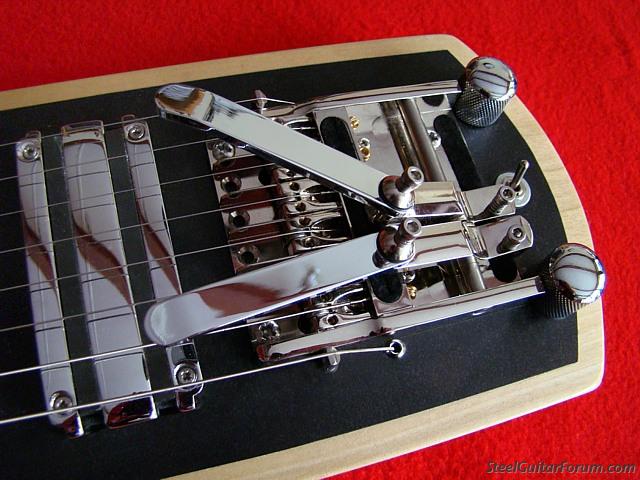
I could not use any existing parts like string trees or metal profiles as those were too big. The string distance of strings 1 and 8 is rather close to the bender body and these rods and string-through-the-body setups worked out perfectly. And since strings 2 to 6 are fully height adjustable on the bender, I did not have to worry about the string height of strings 1 and 8. 

The Alumitone pickup legs sit inside two slots I cut in the body and I also removed enough wood to accommodate the transformer. I did not have to route a big pocket for the Alumitone pickup.
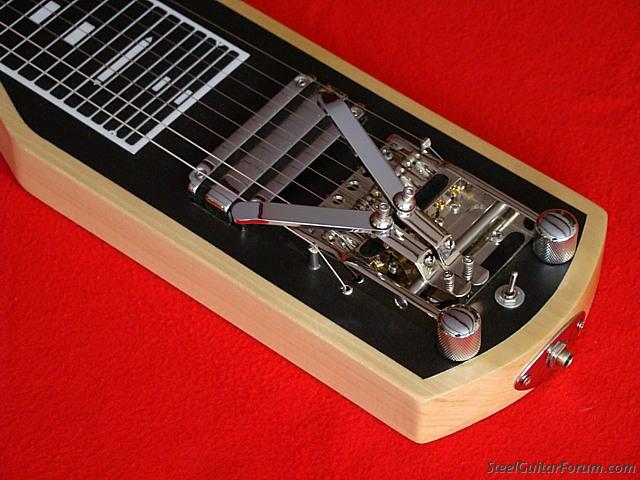
And the controls-space is big enought to allow for 2 pots, a capacitor, 1 coil-switch and the 1/4" jack socket. Although the layout might appear a bit cramped, there is ample space to use the controls.

For the moment I used E9th Pedal Steel tuning, omitting string 7 and 9 (F# and D). String 8 on this guitar can be tuned to either D(E9-str9) or low B(E9-str10). The levers are on strings 5 and 6 (B and G#) raising B two steps and G# one step. I kept the chromatic strings on top.
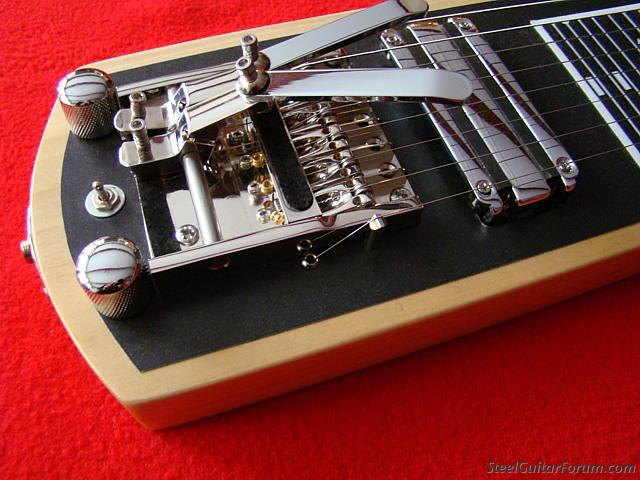
I need to try this for a while and I might change the tuning completely if it does not work out well.

_________________
1977 Sho~Bud D10 ProIII Custom; Sho~Bud SD10 The Professional ; ETS S10 5x5;
Fender 1000; 1993 Remington U12; 1978 Emmons S10 P/P; GeorgeB Weissenborn;
Fluger Cat-Can; Asher Electro Hawaiian; Gibson BR4; Fender FS52; Guyatone 8str;
Fender Resonator ; Epiphone Coronet 1937; Rickenbacher Ace; Rickenbacher NS;
Dynalap 8string; Harbor Lights 8string; Aiersi Tri-Cone; Fender Stringmaster |
|
|
 |
Alan Brookes
From:
Brummy living in Southern California
|
 Posted 24 Jun 2012 9:34 am
Posted 24 Jun 2012 9:34 am |
|
Looks like a good job to me. How does it sound?
I did a similar conversion a while ago, but I used a four-lever Duesenberg. In practice I've found that I only ever use two. The main drawback of these units compared to a pedal steel is that there's no way of pulling more than one string with each lever. I've often wondered whether a standard pedal steel mechanism could be modified to work with palm levers. |
|
|
 |
Tom Pettingill
From:
California, USA (deceased)
|
|
|
 |
Jerry Gleason
From:
Eugene, Oregon, USA
|
 Posted 24 Jun 2012 11:30 am
Posted 24 Jun 2012 11:30 am |
|
| Nice job! Nice photos, too. |
|
|
 |
Peter den Hartogh
From:
Cape Town, South Africa
|
 Posted 27 Jun 2012 5:00 am
Posted 27 Jun 2012 5:00 am |
|
Thanks for the compliments, guys.
Clean Job? You should have seen the amount of dust in the pictures before I used Photoshop to clean it up! 
The sound of the guitar is like most modern lap steels with a single coil pickup, but when I use the bender arms, the sounds changes and it does not sound
good to my ears.
The reason is, of course, because my hand is now forced to pick closer to the bridge when using the benders. As soon as my hand picks closer to the neck, the sound improves.
In addition, it is more difficult to pick firmly while using the benders. I guess I have learn to pick with more authority when bending the strings. Practice, practice, practice. Oh, well.  |
|
|
 |
Alan Brookes
From:
Brummy living in Southern California
|
 Posted 27 Jun 2012 8:01 am
Posted 27 Jun 2012 8:01 am |
|
| I guess that's why foot pedals became so popular. |
|
|
 |
Mike Neer
From:
NJ
|
 Posted 27 Jun 2012 8:04 am
Posted 27 Jun 2012 8:04 am |
|
| Peter den Hartogh wrote: |
Thanks for the compliments, guys.
Clean Job? You should have seen the amount of dust in the pictures before I used Photoshop to clean it up! 
The sound of the guitar is like most modern lap steels with a single coil pickup, but when I use the bender arms, the sounds changes and it does not sound
good to my ears.
The reason is, of course, because my hand is now forced to pick closer to the bridge when using the benders. As soon as my hand picks closer to the neck, the sound improves.
In addition, it is more difficult to pick firmly while using the benders. I guess I have learn to pick with more authority when bending the strings. Practice, practice, practice. Oh, well.  |
Would it be more feasible to use your arm or wrist to push the levers?
_________________
Links to streaming music, websites, YouTube: Links |
|
|
 |
Peter den Hartogh
From:
Cape Town, South Africa
|
 Posted 27 Jun 2012 8:29 am
Posted 27 Jun 2012 8:29 am |
|
I tried that, Mike. But it is not really a matter of just pushing down.
With the 2 benders, you need to position them in a certain way so you can simulate what would be the footroll on an E9th PSG.
Also, the benders have a different length of travel.
Basically these benders simulate the A pedal and the B pedal of an E9th PSG.
The A-lever on the bender has a long travel, which I need to make shorter, and the B-lever travel needs to be made longer.
I use the karate edge of my hand to control both levers...the B-lever gets pushed with the part closest to the wrist and the A-lever with the part closest to the pinky. The easiest way to do this is to point the B-lever (wrist side) towards the player and the A-lever towards the nut...parallel to the strings.
It works quite well, but I need to fine-tune the string-gauges to adjust the travel and I need to lock the levers' pointing direction, as they are all over the place at the moment.
After the adjustments are made I can concentrate on the picking.
I just made this thing for fun and to try some kind of a portable PSG.
(LSG? Lever Steel Guitar?  BSG? Bender Steel Guitar?) BSG? Bender Steel Guitar?) |
|
|
 |
Alan Brookes
From:
Brummy living in Southern California
|
 Posted 27 Jun 2012 11:17 am
Posted 27 Jun 2012 11:17 am |
|
| Mike Neer wrote: |
| ...Would it be more feasible to use your arm or wrist to push the levers? |
Given the design of the unit, you really don't have much choice.
Before I used a Duesenberg I thought that it would interfere with picking, but in reality it doesn't. |
|
|
 |
Steve Ahola
From:
Concord, California
|
 Posted 7 Jul 2012 10:50 am
Posted 7 Jul 2012 10:50 am |
|
| Peter den Hartogh wrote: |
| I just made this thing for fun and to try some kind of a portable PSG. |
Your project looks great! Would it help with the picking problem if the levers were shorter or replaced with ones that had some sort of bend to them?
Steve Ahola
P.S. I wanted to mention that for anyone looking for a portable pedal steel Fessenden does make a very limited number of 6 string pedal steels (the Six Shooter.) I have a hunch that Jerry makes these up when he's not working on orders for his "real" PSG's. The build quality of them is top-notch. I have mine set up with an E9 lap steel tuning with the two pedals raising it to A6. (Unlike a "real" PSG it is very simple to reconfigure the undercarriage for different tunings and copedants.)
_________________
www.blueguitar.org
Recordings on electric guitar:
http://www.box.net/blue-diamonds
http://www.box.net/the-culprits |
|
|
 |
Peter den Hartogh
From:
Cape Town, South Africa
|
 Posted 7 Jul 2012 11:55 am
Posted 7 Jul 2012 11:55 am |
|
Thanks Steve.
I am getting more used to the levers, so it is getting better.
I just want the whole tone lever to have a shorter travel.
Do I need a thicker string or a thinner string to achieve a shorter travel?
I am never sure about that. Right now my bender bends plain strings only.
I am wondering if I should add a lower lever underneath the lap steel,
but I run the risk that people start calling me "Clever Dick". 
Here is a link to Jerry's Six Shooter:
http://bb.steelguitarforum.com/viewtopic.php?t=210400&view=previous&sid=c32cc4c915ee84c1ff39f75c0cf26f07 |
|
|
 |
Alan Brookes
From:
Brummy living in Southern California
|
 Posted 7 Jul 2012 5:23 pm
Posted 7 Jul 2012 5:23 pm |
|
You need a thicker string for shorter travel, but not so thick that it breaks. One of the main drawbacks of the Multi-Bender is that it should have been designed with rollers on the bridge. As it is, strings break too often.  |
|
|
 |
Stephen Cowell
From:
Round Rock, Texas, USA
|
 Posted 7 Jul 2012 6:57 pm
Posted 7 Jul 2012 6:57 pm |
|
| Alan Brookes wrote: |
| You need a thicker string for shorter travel, but not so thick that it breaks. (snip) |
I'm putting my money on the opposite... that you need a *thinner* string for shorter travel. I find that I need a thinner string when I want to pull up a full step behind the bar... the looser string has more tension travel in the same stretch space, where the tighter one hits the next string (pulling it out of tune) before I can get the full step.
Think of when you're tuning up the string, using the peg... as it tunes up the pitch changes slower and slower per peg rotation. |
|
|
 |
Peter den Hartogh
From:
Cape Town, South Africa
|
 Posted 8 Jul 2012 1:41 am
Posted 8 Jul 2012 1:41 am |
|
Alan, this bender HAS rollers on the bridge. You can see it in the pics above.
Stephen, you see why I am always confused? 
Two contradicting answers. 
But I'll go along with your suggestion and try a thinner string.
Thank you so much.
UPDATE
Now I am even MORE confused. 
The problem in question is as follows:
I have a raise on string 5 from B to C# (a whole tone).
I am using a .017 plain string and I found that the travel was a bit too long.
I want it shorter.
I decided to try a lighter string to see what happens, so I installed a .012 plain (same as high G#, string 3).
When tuned up to pitch (B below high G#) the string was obviously not up to its full tension because it is 9 half-steps below the high G#.
But surprisingly the travel was the same as previously!
I did not have to re-tune the stops at all. OK, back to the drawing board.
So, what happens if I use a thicker string?
Now there is one right here on the guitar with a bender connected.
String 6 is a .020 plain string and it is tuned to low G# and raises half a step to A.
So to test it, all I had to do tune it up to B (3 half-steps only) and check if the half step raise still works.
Due to the higher tension, the existing half step travel was not even sufficient to complete the step. It did not make the C note.
So I would have to increase the travel, which is contrary to my objective to shorten the travel.
So, is my only option a wound string? A .024 or .026?
Last edited by Peter den Hartogh on 8 Jul 2012 8:17 am; edited 1 time in total |
|
|
 |
Alan Michael
From:
Winston-Salem North Carolina U.S.A.
|
 Posted 8 Jul 2012 8:08 am
Posted 8 Jul 2012 8:08 am |
|
I'm with Mr Brookes......heavier gauge=shorter travel+more string breakage.
Peter, your steel turned out very nice and I have one of Mr. Boards blanks in tiger maple waiting to become a functional 8 string. It won't have a multibender since I already have one on my custom Pettingill 6 string......and it has rollers on the bridge also. |
|
|
 |
Peter den Hartogh
From:
Cape Town, South Africa
|
 Posted 8 Jul 2012 9:08 am
Posted 8 Jul 2012 9:08 am |
|
Hi Alan M.
I was posting my update at about the same time you were posting.
I checked previous forum multi bender posts and J.Wilson suggested a .022 for the B to C# bend.
Update1
Hey! that worked! It is stiffer but shorter. Nice
Update 2
I changed it to a .020.
That took out the stiffness AND the 2 levers feel like a matched pair now.
Perfect.
Last edited by Peter den Hartogh on 11 Jul 2012 9:38 pm; edited 6 times in total |
|
|
 |
Alan Michael
From:
Winston-Salem North Carolina U.S.A.
|
 Posted 8 Jul 2012 11:21 am
Posted 8 Jul 2012 11:21 am |
|
Peter, I have four benders on my steel. Here's my setup:
E...half step raise to F..........15 gauge
B...whole step raise to C#.....18 gauge
G#...halfstep raise to A.........24w gauge
E...half step lower to D#........30w gauge
D...........................................33w gauge
B............................................38w gauge
For what it's worth I have tried every change and tuning in the book and have settled on these. I might also add that the multibender doesn't return to pitch as well when you lower a string.....I will probably remove the lever on my low E since things are a little busy down at the bridge. I use the high E raise on occasions but mostly the A+B pedal moves. |
|
|
 |
Alan Brookes
From:
Brummy living in Southern California
|
 Posted 8 Jul 2012 2:32 pm
Posted 8 Jul 2012 2:32 pm |
|
| Alan Michael wrote: |
| ,,,I might also add that the multibender doesn't return to pitch as well when you lower a string... |
That's what I've found. The spring in the Multibender isn't powerful enough to return the bass strings to pitch. It will never take the place of a pedal steel, but, within its capabilities, it's a useful thing to take along to a gig, because there's no setup involved.
On the subject of string tension, logic says that when a string is under more tension, the travel on the palm lever creates a bigger increased proportion of tension than before it is depressed. Since a thicker string has to be under more tension than a thinner one for the same pitch, you would expect the additional stretching to have more effect on the thicker string.
Of course, things don't always work out in practice how you expect them to.   |
|
|
 |
Tom Pettingill
From:
California, USA (deceased)
|
 Posted 10 Jul 2012 10:52 am
Posted 10 Jul 2012 10:52 am |
|
| Stephen Cowell wrote: |
| Think of when you're tuning up the string, using the peg... as it tunes up the pitch changes slower and slower per peg rotation. |
A good observation. Steel has a certain amount of elasticity and as the tension increases closer to its breaking point, the curve goes flat and there are diminished returns.
The best gauge can vary depending on scale length and other factors, but ultimately it is a balancing act.
For best results for both tone and string life, you want to shoot for something with just enough tension in un-bent mode to be playable and not be lose and flubby. This puts you in the lower end / better part of the elasticity curve.
_________________
Some misc pics of my hand crafted steels
Follow me on Facebook here |
|
|
 |
Alan Brookes
From:
Brummy living in Southern California
|
 Posted 10 Jul 2012 4:46 pm
Posted 10 Jul 2012 4:46 pm |
|
| I find it uncomfortable to work knee levers, and I'm thinking of putting some palm levers on a pedal steel to do the same function. |
|
|
 |
Nate Hofer
From:
Overland Park, Kansas
|
 Posted 14 Jul 2012 11:09 am
Posted 14 Jul 2012 11:09 am |
|
| I wanna hear this! |
|
|
 |
Carl McLaughlin
From:
St.Stephen,New Brunswick,Can
|
 Posted 17 Jul 2012 7:27 pm 8 string bender
Posted 17 Jul 2012 7:27 pm 8 string bender |
|
I have a PETTINGILL w/ duezy benders and was breaking strings to the point of giving up.Tom Pettingill suggested that i slide a uesd ball end from and old string over the new string before i reinstalled it.I ended up useing two ball ends which keeps the end of the string where the wrap finishes from rubbing on the axel,thats where it usually breaks.I tried different gauges,no help.I ground part of the axel away so when the string is pulled it has less contact.Has worked fine ever since.There is a design problem in the fact that the axel itself should either have a nylon sleeve or roller for the string to contact.If you grind it away too much,it wont let you bend it to pitch.It relys on the axel to bend the string around it as well as pullin to pitch..Hope this helps.A heavyer string will give you a shorter move .I know i tried lots of different ways trying to correct the breakage problem..M2$W. Carl 
_________________
I have a Tele plus telecaster, Larrivee acoustic. Also have a Fender resonator guitar with new Quarterman cone and spider, and an Allan tailpiece .Playing through a Fender Super Champ XD, using a little delay on the amp and a Harmonix Holy Grail Echo pedal, set on Hall turned to about 1pm.Just Bought a Yamaha FGX5 Recently and love it. Recently got a Sho-NUFF 6 string pedal steel in open G.Still learning. |
|
|
 |




